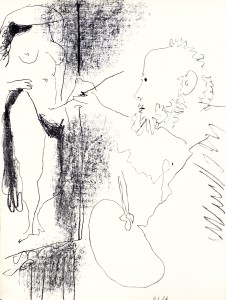Pablo Picasso
Profile
Painter and printmaker (1881 - 1973)
Spanish painter, sculptor and printmaker, Pablo Picasso was born in 1881 in Málaga. Until 1898, he used his father’s name, Ruiz and his mother’s maiden name, Picasso, to sign his pictures. After 1901 he dropped Ruiz and began using his mother’s maiden name when signing his works. Picasso made three trips to Paris from 1900 to 1902, settling there in 1904. He was fascinated by the city’s bohemian street life and his works from that time express human misery, often portraying beggars, alcoholics and prostitutes. After settling in Paris, Picasso became acquainted with Fernande Olivier, the first of many people who influenced the theme, style and mood of his work.
From 1904 to 1905 Picasso changed his palette to pinks and reds. This period came to be known as the “Pink Period”, during which many of his subjects were drawn from the circus, an event that he frequented several times a week. During his first decade in Paris, Picasso established friendships with Max Jacob, Guillaume Apollinaire, Ambroise Vollard, Gertrude Stein and Daniel Henry Kahnweiler.
In 1906 Picasso’s work entered a new phase, influenced by Greek, Iberian and African art. In 1908 he began painting landscapes using “little cubes”, a style that became known as Cubism. Some of his works from this period are so similar that they are difficult to tell apart. Picasso created his first collage in 1912, marking a transition to synthetic cubism. In addition to cubist paintings, he also created cubist sculptures and constructions from odds and ends of wood, metal, paper and non- artistic materials.
Picasso went to Rome during World War II and worked as a designer with Sergey Diaghilev and the Ballets Russes. During this time he met and married dancer, Olga Koklova and, in a realist style, he painted numerous portraits of her around 1917. During the 1930s Picasso stressed harmonious, curved lines in his cubist paintings and in 1935 he made the etching, “Minotauromachy”, a work combining his minotaur and bullfight themes. Shortly after German planes bombarded the Basque town of Guernica in 1937 during the Spanish Civil War, Picasso painted the large mural, “Guernica”.
At the onset of World War II, Picasso’s style had grown somber and death became the subject of numerous works. In 1953 he met Jacqueline Roque, the last of his companions to be portrayed in his work. After 1961 he spent the majority of his time in southern France. A number of Picasso’s latter works were based on works by masters of the past, including Diego Velazquez, Eugene Delacroix, Edouard Manet and Gustave Courbet.
In addition to his paintings, Picasso made hundreds of lithographs in the renowned Paris graphic workshop, Atelier Mourlot. As a printmaker, Picasso initially concentrated on etching, producing “The Vollard Suite" in the 1930s. The suite is comprised of 72 sheets based on five main themes. He also completed a number of ceramics, producing nearly 2000 pieces in 1947 alone. A 1971 exhibition at the Louvre honored Picasso on his 90th birthday. Until then, no other living artist had ever been shown there. Picasso died in 1973 in his villa, Notre-Dame-de-Vie near Mougins.
credits: IFPDA
